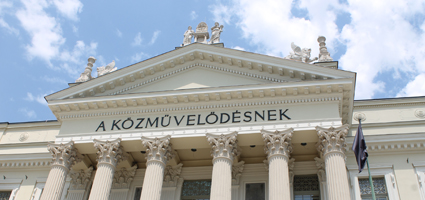2024. October 18. Friday
Ferenc Móra Museum - Museum of Csongrád County Government - Szeged
 |
Address: 6720, Szeged Roosevelt tér 1-3.
Phone number: (62) 549-040
E-mail: info@mfm.u-szeged.hu
Opening hours: Mon-Sun 10-18
|
The exhibition has closed for visitors.
2009.02.20. - 2009.07.27.
Museum tickets, service costs:
|
Ticket for adults
|
1590 HUF
|
|
|
Ticket for adults
(lookout tower)
|
700 HUF
|
|
|
Ticket for students
|
990 HUF
|
|
|
Ticket for students
(lookout tower)
|
500 HUF
|
|
|
Ticket for pensioners
(lookout tower)
|
500 HUF
|
|
|
Individual ticket for pensioners
|
990 HUF
|
|
|
Ticket for families
(max. 2 adults + 2 children)
|
4490 HUF
|
/ family
|
|
Ticket for families
(lookout tower, max. 2 adults + 2 children)
|
2000 HUF
|
/ family
|
|
Combined ticket for adults
(all exhibition places in Szeged)
|
2490 HUF
|
|
|
Combined ticket for students
(all exhibition places in Szeged)
|
1490 HUF
|
|
|
Combined ticket for pensioners
(all exhibition places in Szeged)
|
1490 HUF
|
|
|
Combined ticket for families
(all exhibition places in Szeged, max. 2 adults + 2 children)
|
6990 HUF
|
/ family
|
|
Guide
|
7500 HUF
|
/ place
|
|
Guide
|
10000 HUF
|
/ place
|
The exhibition takes the visitors to Europe hundreds of years ago, to the times when Black Death threatened people. Among others, the visitors can see a quarantined town with a hearse, a pest cross, several pots used in pharmacies and protective clothing used by doctors.
People tried to use both black and white magic to save themselves from the disease believed to be the punishment of God. There are marionettes to show the most typical skin diseases accompanying the disease pest, as well as documentations from the heritage of Sándor Bálint.
The people who suffered in pest felt such a heat that they could not tolerate even the thinner cover on their skin. They preferred staying naked and what they really wanted to do was diving into water. Almost 100% of those suffering in lung pest died of the disease. Pest reached almost all corners of Europe, from Moscow to London. In Milan, the officials immediately walled the patiences suffering from Pest up in houses. The disease transmitted by rats evoked a basic incomprehension in people. Those who had the disease had to eat sour fruit, pomegranate and drink vinegar. They also had to keep from sexual intercourse.
The Tartar used the disease pest as a biological weapon. They put corpses of people died of pest among the city walls thus infecting the inhabitants. After the disease was gone, people were forced to build monumental cathedrals. A special case of hysteria evoked by the disease was the Vampire myth in Bánát and South Transylvania. It was because the epidemic was attributed to vampire in the 18th century.
Researchers say that according to their researches, people nowdays believe that the only positive effect of the pest epidemic is that one out of ten person is immune to AIDS.
People tried to use both black and white magic to save themselves from the disease believed to be the punishment of God. There are marionettes to show the most typical skin diseases accompanying the disease pest, as well as documentations from the heritage of Sándor Bálint.
The people who suffered in pest felt such a heat that they could not tolerate even the thinner cover on their skin. They preferred staying naked and what they really wanted to do was diving into water. Almost 100% of those suffering in lung pest died of the disease. Pest reached almost all corners of Europe, from Moscow to London. In Milan, the officials immediately walled the patiences suffering from Pest up in houses. The disease transmitted by rats evoked a basic incomprehension in people. Those who had the disease had to eat sour fruit, pomegranate and drink vinegar. They also had to keep from sexual intercourse.
The Tartar used the disease pest as a biological weapon. They put corpses of people died of pest among the city walls thus infecting the inhabitants. After the disease was gone, people were forced to build monumental cathedrals. A special case of hysteria evoked by the disease was the Vampire myth in Bánát and South Transylvania. It was because the epidemic was attributed to vampire in the 18th century.
Researchers say that according to their researches, people nowdays believe that the only positive effect of the pest epidemic is that one out of ten person is immune to AIDS.